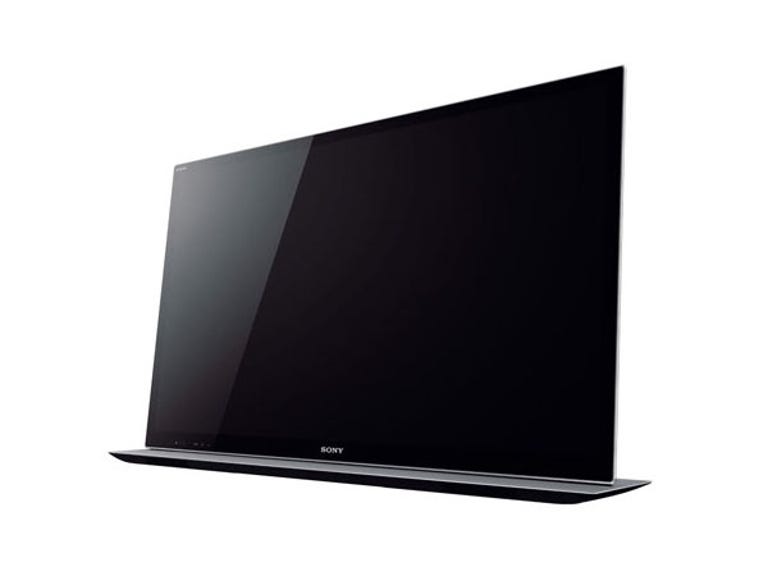 Why You Can Trust CNET
Why You Can Trust CNET Sony Bravia KDL-55HX850 review: Sony Bravia KDL-55HX850
With its one-sheet-of-glass design, the Sony Bravia KDL-55HX850 offers rather good 3D, excellent 2D and a good range of network smarts.
System
Sometimes it can be hard to distinguish between two TV models from the same brand. So what sets the Sony Bravia HX850 series apart from the HX750, aside from price difference? (The price gap is AU$600 for the 55-inch, 140cm model.)
The Good
The Bad
The Bottom Line
Not much, at first glance. They even use identically numbered firmware. But look a bit closer, and you'll see that the more expensive model gets the full-sheet-of-glass treatment, in which the bezel doesn't protrude forwards, but is simply blanked out in sections on the underside of the glass. The glass itself is Corning Gorilla Glass, so it should stay looking good. The panel is also quite thin, at just 35mm. The stand has a kind of forward-reaching neck, so there is no obvious pedestal, giving the unit a free-floating look.
This TV is also compatible with the optional speaker stand. This is a low-set aluminium-look bar with built-in active loudspeakers. It allows better sound, and lets the TV tilt back by 6 degrees.
The bezel, at 28mm to 31mm in width, is far from the leading-edge 3mm width offered by some brands.
As seems to be increasingly the case with various TV brands that things like contrast ratio and brightness are not specified for the panel. But it does offer the usual full high-definition resolution, and full support for 3D. This uses an active system with synchronisation by means of IR (the IR transmitter is built in to the TV). You get one set of glasses — fairly chunky 56-gram ones — with the TV. Additional sets cost AU$149. They use rechargeable batteries, so you will need to plug them in to USB ports a couple of times a year. Those on the TV suffice.
The TV has the usual ports — support for everything except S-Video. There is a headphone output that can be used, at a pinch, to feed an analog sound system. The HDMI connection supports such up-to-date things as the Audio Return Channel on HDMI. As with the HX750 series, though, this tends to make the remote control lose its focus on controlling the TV, and shift over to controlling the source device.
Picture
The standard out-of-the-box picture in 2D was very nearly as good as it gets. The colour was rich and plasma-like, the black levels were excellent and the brightness was strong. The only weakness was a very slight edginess to the picture. The culprit was mostly Sony's "Reality Creation" processor, which applied some kind of sharpening process to the picture. It wasn't a standard kind, because it didn't produce much ringing, but it did tend to make sloped and curved lines just a little jagged, and it even generated a false element on one of the test patterns we use. Switching this off (along with Edge Enhancer) made the picture smooth and beautiful. (Note: we usually recommend turning down the "Sharpness" control to 0, but with this TV, "50" is actually the position with no artificial sharpening. Going below this softens the picture.)
Where this TV really departs from the HX750 is with 3D. It is the TV itself, because the glasses are the same with both sets. On a test pattern, the breakthrough of white from one eye into the blacks of the other eye was around 40 per cent, which is a terrible-looking figure, but in practice isn't too bad. The reverse — blacks from one eye breaking into whites of the other eye — was close enough to a perfect score of 0 per cent. The net result was a near-plasma level of 3D performance. There was some crosstalk, or ghosting, but most of the time it was at a low enough level to be neither intrusive nor damaging to the 3D effect.
Goodies
As with the HX750, Sony is using a modified form of its old X-Bar on-screen menu system. This allows the picture display to continue in a window in the corner of the screen. It can be a bit confusing, with some elements of the extensive network extensions — catch-up TV services and the like — repeated in different parts of the menu. That, combined with the remote frequently giving over some of its important keys to control source devices, led to some irritations in trying to control the TV.
Nonetheless, the range was good, and includes the Sony Entertainment Network for platform-specific video and music offerings for subscribers. Connection can be wired or by means of the built-in Wi-Fi.
The iOS control app (there is an Android one as well) gives additional control over the unit, with the ability to guide a mouse pointer, useful for web access. There is also the ability to "Catch and Throw" web pages between the TV and a mobile device.
A standard feature these days for mid- to high-end TV is a PVR function: plug in a USB hard drive, and you can record and time shift. But Sony is the only major brand that does not offer this. If you have a separate PVR, you may not care, but the ability just to hit "Pause" while watching TV from the unit's own TV tuner can be very convenient — a convenience that is lacking here.
Overall
It costs quite a bit more than the next model down, but nonetheless the Sony Bravia KDL-55HX850 is a worthwhile step up in performance.


